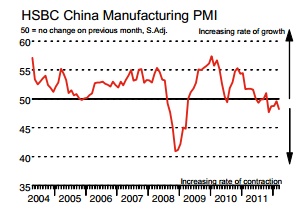Equity markets were mixed today, with Asian indices trading lower following the release of a weak Chinese PMI, European markets bouncing back from yesterday’s swoon (despite weak PMI data that showed manufacturing contraction throughout the continent – including Germany), and North American markets essentially flat.
Today’s action was focused on currency markets, with the euro selling off over the course of the day while hovering above the 1.25 EURUSD level. After breaching EURUSD’s 2012 low during yesterday’s session, the common currency continues to trade lower even on ‘equity up’ days – definitely a sign of stress.
In a speech delivered in Rome today, ECB President Draghi said that:
[quote]we have now reached a point where the process of European integration needs a brave leap of political imagination.[/quote]
What is this “brave leap forward” to which he’s referring? Speculation in the press ranges from the issuance of so-called “Eurobonds” backed jointly and severally by all of the European nations to the initiation of a “banking union” that would guarantee deposits across the continent.
As we have mentioned elsewhere, irrespective of the pros and cons of any of these proposals, it seems as though European leaders want to delay any decision until Greece completes its elections on June 17 and leaders can gauge whether the new Greek governing coalition will wish to renegotiate the terms of the bailouts administered up until now.
Aside from the weak PMI data in Europe, US durable goods orders for April were fairly weak. While orders increased by 0.2% m/m, that obscured weak trends ex-transportation (if planes and cars are excluded, orders were down by -0.6% m/m).
Euro Dollar
EURUSD (1.2530) The US dollar has extended its gains against the euro and other major currencies as investors sought safety as Europe’s leaders struggle to contain Greece’s debt crisis.
The euro was traded at $1.2532 on Thursday down from $1.2582 at the same time the previous day.
The embattled European currency earlier had plunged to $1.2516, its lowest level since July 2010, after a European Union summit late Wednesday produced no clear path forward in the debt crisis and markets were besieged by a slew of discouraging economic data for the eurozone and Britain.
The Sterling Pound
GBPUSD (1.5656) Sterling edged up from a two-month low against the dollar on Thursday as some investors booked profits on bearish bets, although expectations of further monetary easing after the UK economy shrank more than first thought could keep a lid on gains.
The downward revision in gross domestic product to -0.3 percent from an initial estimate of -0.2 percent deepened concerns about the economy’s vulnerability to the euro zone debt crisis. That added to bets the Bank of England may opt for more asset purchases to boost growth.
The pound dropped briefly against the dollar after the GDP release to around $1.5648, before paring losses to last trade up 0.2 percent on the day at $1.5710.
Earlier in the session it hit a two-month low of $1.5639 as widespread concerns about a possible Greek exit from the euro led investors to safe-haven currencies like the dollar and away from perceived riskier currencies like the pound.
Asian –Pacific Currency
USDJPY (79.81) The JPY is unchanged from yesterday’s close, as movement remains limited in the absence of domestic data. BoJ Governor Shirakawa has spoken about the need to improve Japan’s fiscal metrics given concerns over the potential impact of rising bond yields in the world’s most indebted country.
Poor fiscal balances, stagnant growth, easy policy, and weak demographics are key to our weak (long‐term) JPY forecast.
However, in the short term, safe haven flows will drive yen strength, as evidenced by the recent decline in EURJPY which has begun to consolidate around 100.00.
Gold
Gold (1553.15) futures have gained for the first time this week, as a brief pause in the US dollar’s upward march spurred some investors who had bet on lower prices for the precious metal to close out those bets.
The US dollar was lower against some major trading partners early in New York’s trading day, as this week’s escalation in worries about Europe’s sovereign-debt crisis slowed.
Some upbeat US economic data and gains in European markets limited demand for the currency as a safe haven, and European leaders at a summit re-affirmed their wish for Greece to remain in the euro zone, though they didn’t announce any new agreements to contain the spread of the euro zone’s crisis.
That, in turn, supported the battered gold market.
The most actively traded gold contract, for June delivery, rose $9.10, or 0.6 per cent, to settle at $1,557.50 a troy ounce on the Comex division of the New York Mercantile Exchange.
Crude Oil
Crude Oil (90.48) prices have perked up after European leaders re-affirmed their desire to see Greece stay in the euro and Iran and world powers deadlocked in talks over its disputed nuclear program. New York’s main contract, West Texas Intermediate (WTI) crude for delivery in July, rose 76 cents to close at $90.66 a barrel. The WTI futures contract had hit $89.90 on Wednesday, its lowest level since October.
In Baghdad, two days of tough talks aimed at helping resolve the stand-off between major oil producer Iran and major economies over Tehran’s nuclear program wound up with no significant progress.
Major powers Britain, China, France, Russia and the United States plus Germany tabled a proposal that included sweeteners to persuade Iran to abandon enriching uranium but Tehran baulked at the offer. Iran has faced crippling sanctions over its nuclear program, which much of the international community believes is masking a push to develop atomic weapons.
Tehran denies the claims.
The parties agreed to meet again in Moscow on June 18 to 19, said EU foreign policy chief Catherine Ashton.



